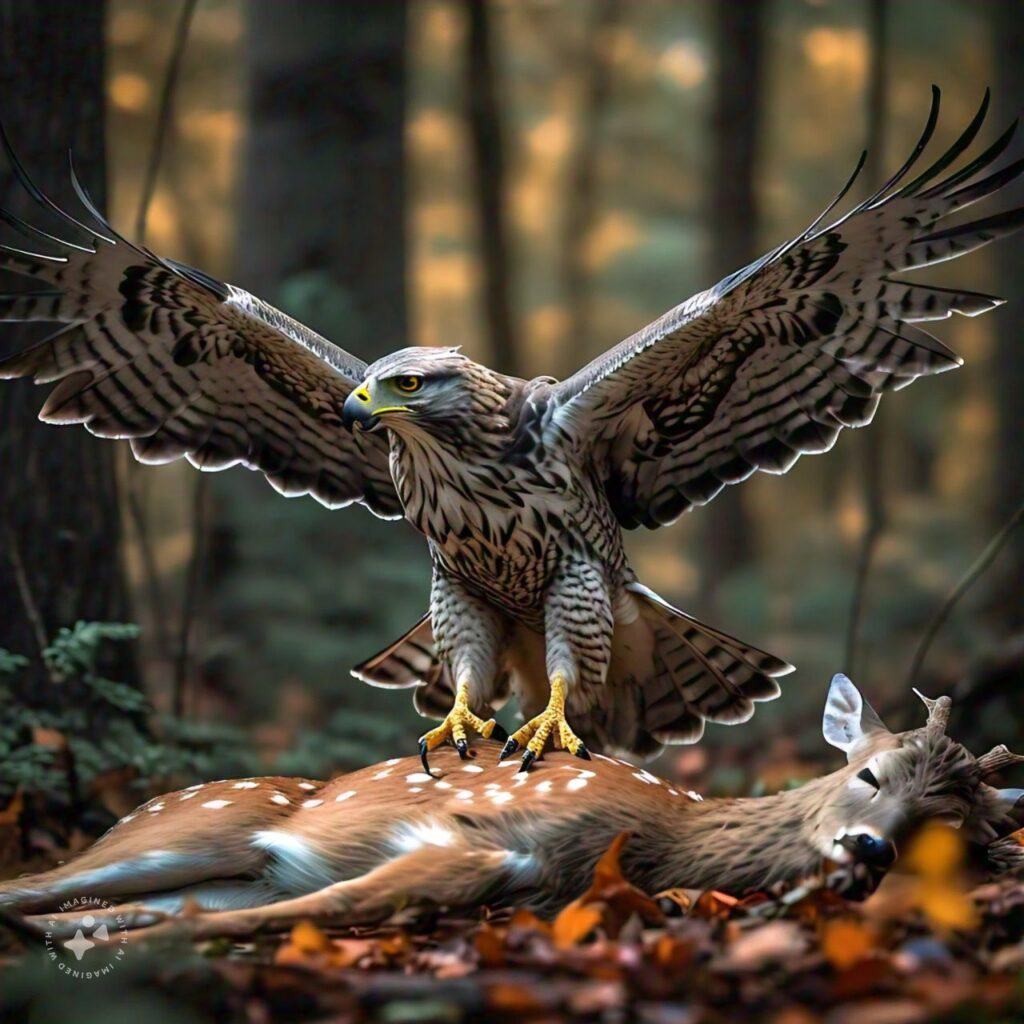Do Hawks Eat Deer?
Hawks primarily prey on smaller animals like rabbits, squirrels, reptiles, fish, and insects. However, they have been observed to target larger prey such as deer on rare occasions. This typically occurs when the deer is vulnerable due to youth, illness, or injury. In such cases, hawks may attack deer, primarily aiming to cause fatal injuries using their talons and beaks.
The likelihood of hawks preying on healthy adult deer is low due to these animals’ significant size and strength. Hawks generally rely on hunting smaller, more manageable prey that they can capture efficiently from the air.
Do Hawks Eat Bats?
It’s important to note that while hawks are predominantly hunters, they also scavenge opportunistically. If a hawk encounters a dead deer from natural causes or another predator’s activity, it may consume it as a food source.
Types of Hawks that Prey on Deer
In the realm of raptors, a few notable species stand out for their impressive hunting capabilities, including their ability to take down prey as large as deer. While hawks primarily target smaller mammals, birds, and reptiles, certain species have been observed hunting deer, particularly fawns or weakened individuals.
Red-tailed Hawks
Red-tailed hawks (Buteo jamaicensis) are formidable hunters known for their broad diet. Although they typically prey on small mammals like rodents and rabbits, there have been documented cases where red-tailed hawks have attacked young deer, particularly fawns. This behavior is more common when other prey sources are scarce, and the hawk is driven by hunger.

Harris’s Hawks
Harris’s hawks (Parabuteo unicinctus) are unique among raptors for their cooperative hunting behavior. While they predominantly hunt smaller creatures such as rabbits and birds, they have been observed taking down larger prey like hares and even young deer. Their social structure, which allows them to work together in hunting, gives them an advantage in tackling larger animals.

Do Hawks Eat Dead Deer?
Hawks indeed consume dead deer under specific circumstances. While hawks generally prefer hunting live prey, they may resort to scavenging dead deer when opportunities arise. This behavior is more noticeable during winter when food is scarce.

Some species like the ferruginous hawk and the red-tailed hawk can hunt and consume deer. However, even these larger hawks usually opt for smaller prey items unless conditions prompt them otherwise. Hawks are more likely to scavenge carcasses left by other predators such as bears and lions, particularly when these animals have hunted deer.
Overall, while hawks do eat deer, it is not a primary or common part of their diet. Their natural preference is to hunt live prey, but they may opportunistically consume dead deer when circumstances permit, especially during times of scarcity like winter. Therefore, while it is not an everyday occurrence, hawks can feed on dead deer under certain conditions.
Can A Hawk Pick Up A Deer?
The ability of a hawk to pick up a deer largely depends on the species of hawk and the size of the deer. Most hawk species are not capable of lifting a full-grown deer due to their size and strength limitations. Hawks typically hunt smaller prey such as rodents, birds, and small mammals that they can manage with their talons.

However, there are exceptions. Larger hawk species like the ferruginous hawk and the red-tailed hawk, which have impressive wingspans and powerful talons, may be able to lift smaller or younger deer. Even then, it would be rare for a hawk to pick up a full-grown adult deer.
How Hawks Hunt and Kill Deer
Hawks are formidable hunters known for their aerial prowess and sharp predatory instincts. While they primarily target smaller prey like rodents and birds, certain larger species of hawks have been observed hunting and killing deer under specific circumstances.
Hunting Strategy
Hawks are opportunistic hunters, often relying on surprise and speed to catch their prey. When targeting deer, hawks typically select individuals who are weakened, injured, or very young. This selection is crucial because deer are generally much larger and more powerful than hawks, making a direct assault on a healthy adult deer nearly impossible.
Choosing Vulnerable Targets
In the rare instances where hawks have been observed hunting deer, they often target fawns or injured adult deer. Fawns are smaller and more vulnerable, lacking the speed and experience of adult deer. Injured deer also present easier targets, as they may struggle to evade an airborne predator effectively.
Execution of the Hunt
The hawk will typically survey the ground from a high vantage point, such as a tree or a rocky outcrop, searching for signs of vulnerable prey. Once a suitable target is identified, the hawk will swoop down swiftly and silently. The element of surprise is crucial, as deer are incredibly alert and can quickly escape from potential threats.
Attack and Killing
Upon closing in on the target, the hawk will use its powerful talons to strike and immobilize the prey. Hitting with precision, the hawk’s talons can puncture the deer’s skin, leading to injuries that can be fatal. Larger hawks, such as certain species of eagle, are known for their ability to exert considerable force with their talons, which can be enough to subdue smaller deer.
Understanding the Impact of Human Activities on Ecosystems
Human activities exert profound influences on ecosystems, often leading to significant changes in biodiversity, ecological balance, and overall ecosystem health. These impacts can be far-reaching and affect not only local environments but also global ecological systems.
Habitat Destruction and Fragmentation
One of the most substantial impacts of human activities on ecosystems is habitat destruction and fragmentation. As populations grow and urbanize, natural habitats are cleared for agriculture, infrastructure development, and residential areas. This alteration of landscapes disrupts the intricate balance of ecosystems, leading to habitat loss for countless species. Fragmentation can isolate populations, making it difficult for organisms to find mates, food sources, or suitable habitats, ultimately threatening their survival.
Introduction of Invasive Species
Human activities often introduce non-native species into ecosystems, either intentionally or unintentionally. These invasive species can outcompete native organisms for resources, disrupt food chains, and alter natural habitats. Invasive species can cause declines in native species populations and even lead to their extinction in extreme cases. The impact of invasive species can be particularly devastating on islands and isolated ecosystems with unique flora and fauna.
Pollution and Contamination
Pollution from industrial, agricultural, and domestic sources poses a severe threat to ecosystems worldwide. Chemical pollutants, such as pesticides, heavy metals, and plastics, can accumulate in soils, water bodies, and the air. This pollution can disrupt ecological processes, harm wildlife, and contaminate food chains. For instance, marine pollution from plastics not only endangers marine life through ingestion and entanglement but also affects entire ecosystems from coastlines to deep-sea habitats.
Climate Change
Human-induced climate change is altering ecosystems at an unprecedented rate. Rising temperatures, changing precipitation patterns, and increasing atmospheric carbon dioxide levels are affecting the distribution and behavior of species. Many ecosystems, such as coral reefs, polar regions, and tropical rainforests, are particularly vulnerable to these changes, threatening the survival of numerous species adapted to specific environmental conditions.
Overexploitation of Resources
Human exploitation of natural resources, such as overfishing, deforestation, and unsustainable hunting, can deplete populations of key species and disrupt ecosystem functions. Overexploitation can lead to the collapse of fisheries, the degradation of forests, and the loss of biodiversity. Additionally, it can have cascading effects on entire ecosystems, impacting the stability and resilience of ecological communities.
FAQ’S
What is a deer’s biggest predator?
The deer’s biggest predator varies depending on the region and the specific type of deer. Generally, the primary predators of deer include large carnivores such as wolves, cougars (also known as mountain lions), bears, and occasionally jaguars in certain regions. These predators are capable of hunting adult deer, particularly those that are young, injured, or vulnerable.
In North America, for example, wolves are significant predators of deer, especially in areas where deer populations are abundant. In regions with dense forests, cougars are skilled hunters capable of ambushing and bringing down adult deer. Bears also prey on deer, especially during certain seasons when they are more active hunters.
What does a hawk eat?
Hawks primarily hunt small mammals such as voles, rats, rabbits, and ground squirrels. Additionally, they are skilled at capturing birds, including those as large as pheasants. Reptiles, especially snakes, are also a common prey item for hawks.
In addition to these main food sources, hawks sometimes consume bats, frogs, toads, and various insects. Their diet is quite adaptable, and they may opportunistically feed on other creatures depending on availability and opportunity. Furthermore, hawks are known to scavenge carrion, particularly when other fresh prey is scarce.


